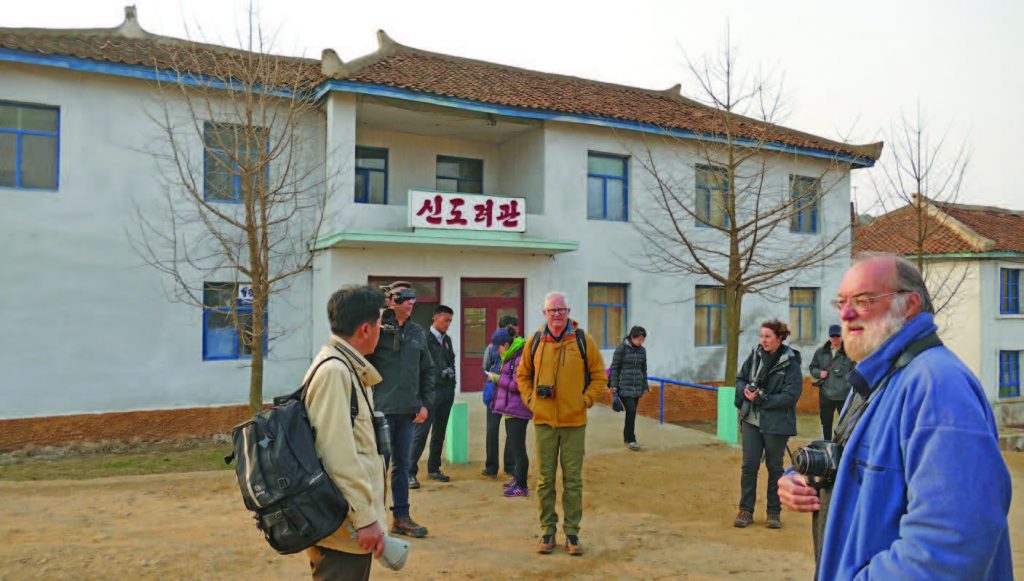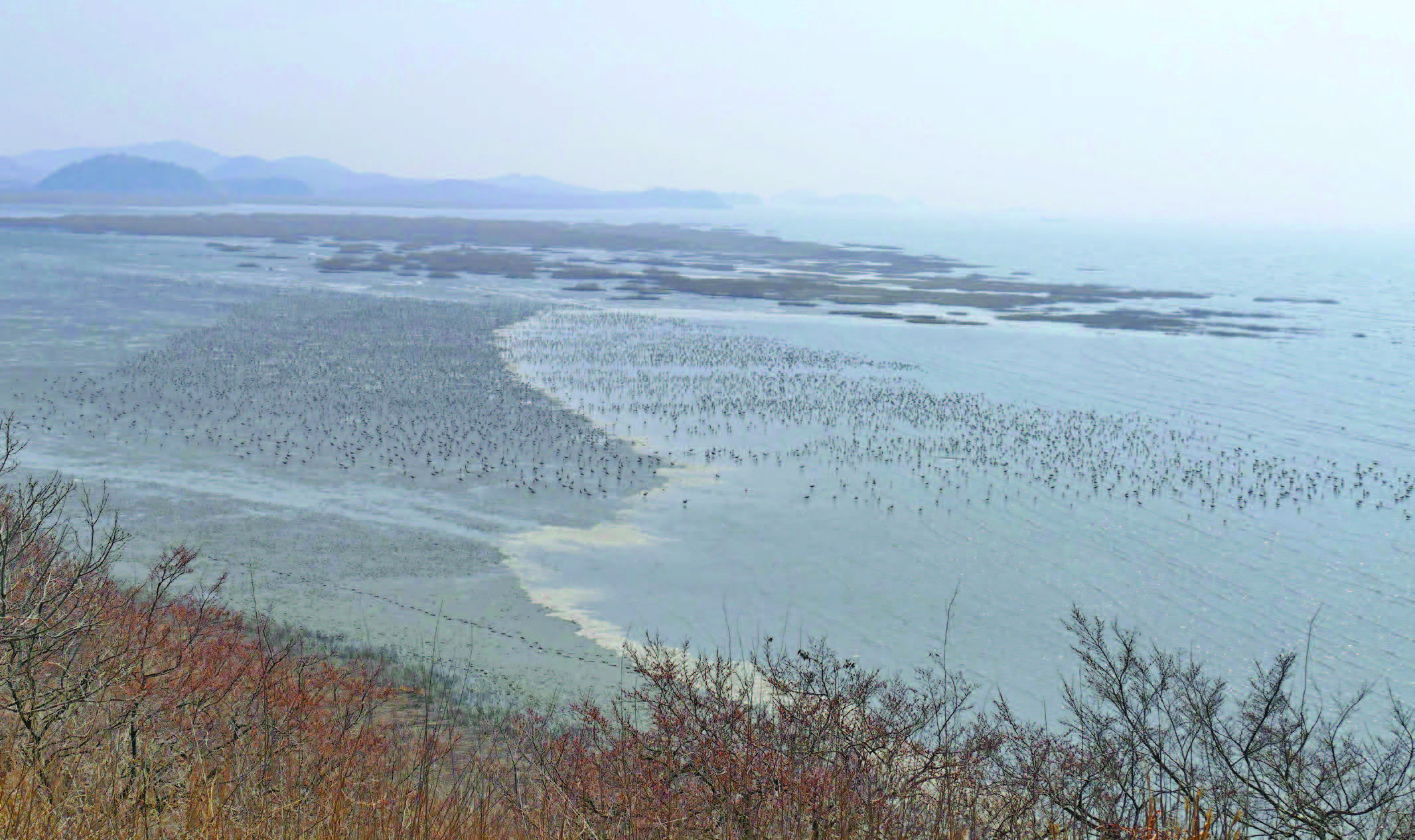
PMNT’s groundbreaking work to locate – and consequently seek to protect – the roosts around the Yellow Sea vital to our migratory shorebirds has just taken two huge steps forward. One team of observers has just returned from North Korea after finding an internationally significant site for Bar-tailed Godwits and Far Eastern Curlew on the Korean side of the Yalu River. Simultaneously a second team was on the already well-known Chinese side of the river to see whether the birds move between the two countries in response to the tides. Keith Woodley reports from Sindo in the Democratic People’s Republic of Korea, and on page 10 Nigel Milius reports from Yalu Jiang in the People’s Republic of China.
Sunlight bounced off brightly coloured godwits massed on the flats. There were several slabs of them extending upstream until lost from view behind a seawall. Birds in such numbers we had seen before, particularly during earlier visits to Yalu Jiang. The backdrop too was slightly familiar although now seen from an utterly different perspective. Across the river stood the enormous 7 km long backdrop of Dandong port – its bright cranes, silos and ships extending down the channel as far as we could see. There was also the familiar striped stack of the power station so familiar to any visitor to Yalu Jiang. But now it was behind the port. For we were now across the Yalu River and into North Korea, on the south west end of Sindo. And we were about to make a stunning discovery. The border crossing two days earlier, for the team of Adrian Riegen, Keith Woodley, David Melville and a crew from TVNZ, had not been as we expected. We knew of course that our transit would be brief, for we were merely crossing the river to Sinuiju, the town we had so often looked upon from Dandong.
Cleared by Chinese immigration and customs we arrived on the platform and found the train, bound for Pyongyang, consisted of sleeper cars, each narrow compartment lined with narrow bunks, three high. Into one of the few vacant ones we piled with our gear, stacking baggage all over the bunks and into any other available space. There were six of us and with the film crew’s equipment there was a lot of baggage and barely room for us to stand.
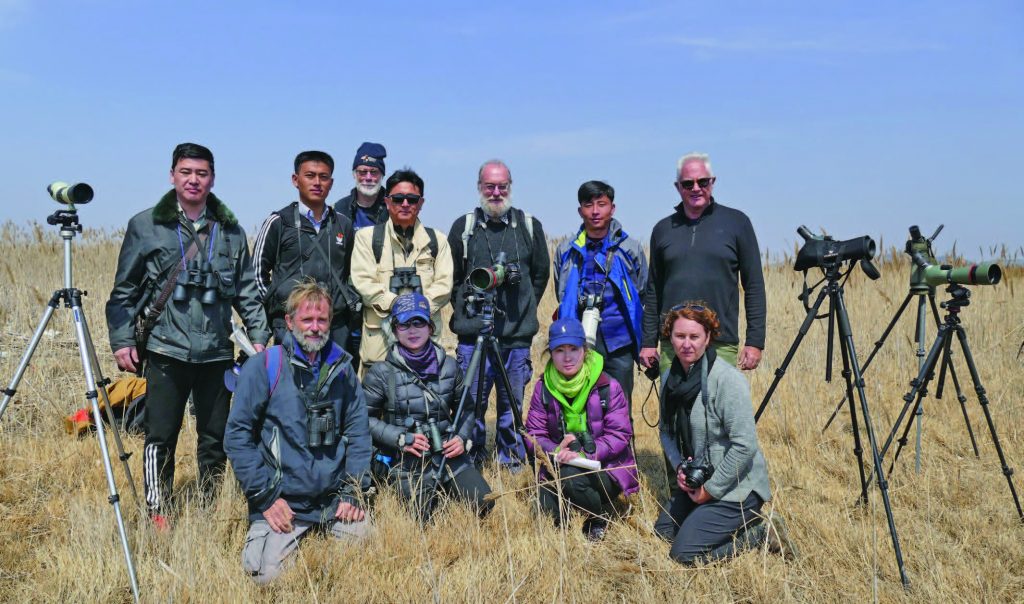
We then found we needed to have our baggage piled near the end of the car ready for a swift exit. We formed a chain, manoeuvring bulky items through tiny confined spaces, as the train began to move. Between this and the need to complete paperwork for Korean immigration, there was little opportunity to enjoy the ride. Beneath us flowed the swift current of turbid water. A glimpse of the bombed bridge ending in mid-stream – and we were across, pulling into Sinuiju station. There on the broad open platform lined with border officials was Ri Song Il acting director of NCUK who had done so much to organise this visit, and Ju Song I our NCUK colleague from all previous visits. Although in the past we had always flown into Pyongyang, for our team there was still much that was familiar. But for our companions from TVNZ Sunday programme, it was all very exotic.
Now on Sindo we were busy surveying. Before us lay a vast area of pristine mudflat covered in birds. Everywhere there were curlews, their eerie cries were to be a constant backdrop to our time on the island. Nowhere else in China or in the south had we seen this – a place where the only footprints on the mud were from birds. There were no fishermen out there, no nets, no people harvesting shellfish – just curlews and godwits and other shorebirds.
Our final estimates for the day were 13,000 godwits and 5000 of the two curlew species, perhaps evenly split between Eurasian and Far Eastern. With the flood tide birds left the river bank and the flats immediately to the south and drifted off to our left. They gathered in several small tidal inlets lined with reeds. With the rising tide they were extremely restless, on one occasion taking flight in an impressive roar as a Peregrine Falcon passed over. But at full tide they settled and slept.
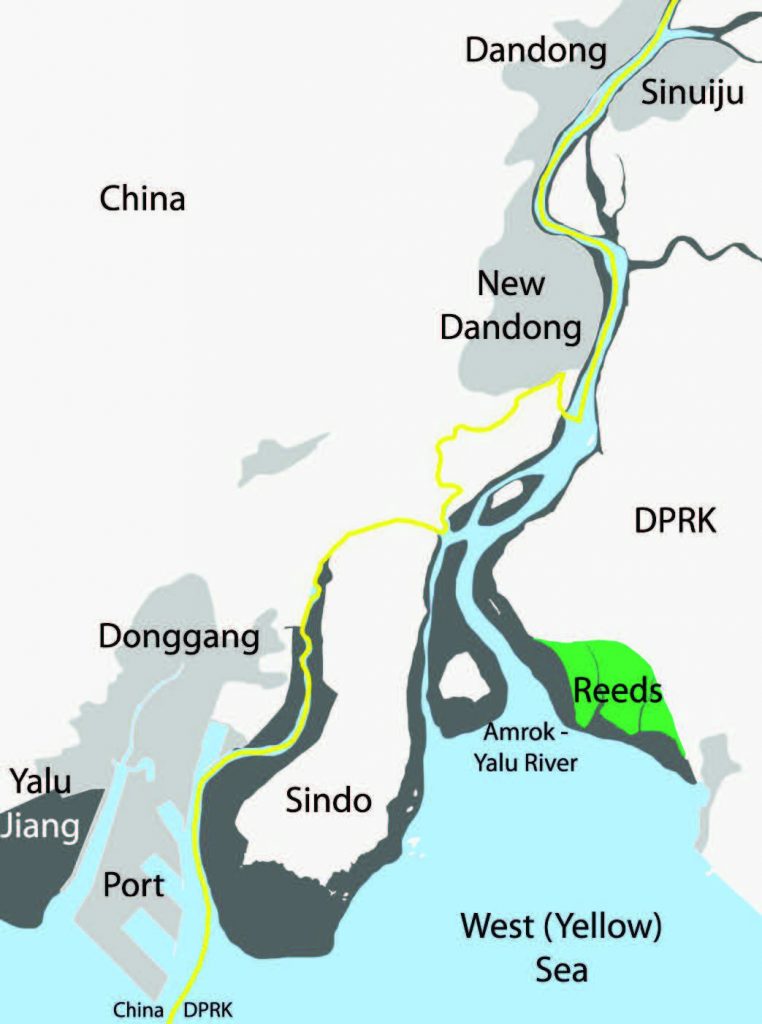
The reeds allowed us close approach. There followed one of the best shorebird viewing experiences I have had anywhere around the Yellow Sea. There had been of course the spectacular flocks at Saemangeum in 2006, and a number of grand spectacles in the early years at Yalu Jiang. But here in one of the inlets, barely 30 metres away, were thousands of godwits, a few hundred Great Knots, and, scattered along the edge of the flock and massed around the back hundreds of curlews – all sleeping.
Godwits are usually very wary birds, curlews even more so, but clearly these birds were quite relaxed, an indication perhaps of how little disturbance they face here. For Martin Anderson the cameraman this was the first opportunity to film close-ups of these remarkable birds in good light.
The closeness of the flock allowed a good opportunity for reading bands and flags, although its density meant many marked birds went unrecorded. But we found birds from Pukorokoro Miranda, Nelson and the Catlins, from Northwest Australia and Queensland, Thailand and China.
We returned the next day, descending from the vehicle to the ubiquitous cry of curlews. This time we climbed the small hill, from the lower flank of which we had started our count the day before.
From the top, the view was quite spectacular. Southeast along the coast were huge areas of reed beds and marsh, before a backdrop of distant hills. In front, and immediately below us were the mudflats that ended in the reed-filled inlets that had served us so well yesterday.
There were thousands of godwit and curlew, most of them being shepherded by the tide line which we could see pushing below them. Equal numbers of birds remained in the water – but gradually the entire tableau was moving steadily shoreward, an animated stain flowing up the beach.
What was truly novel was our vantage point. Normally wader flocks are seen from on or near ground level, from where they appear jammed together as a tight mass. But from here each bird could be seen in isolation with space all around it.
At the base of the hill sat a plinth referring to Elephant Island. Our hosts pointed to a very large rock slightly offshore that was shaped like an elephant. From this angle it was unconvincing. However, once we started walking around towards the reeds it all became clear: it was indeed a remarkable likeness. So we came to know this site as Elephant Island Bay.
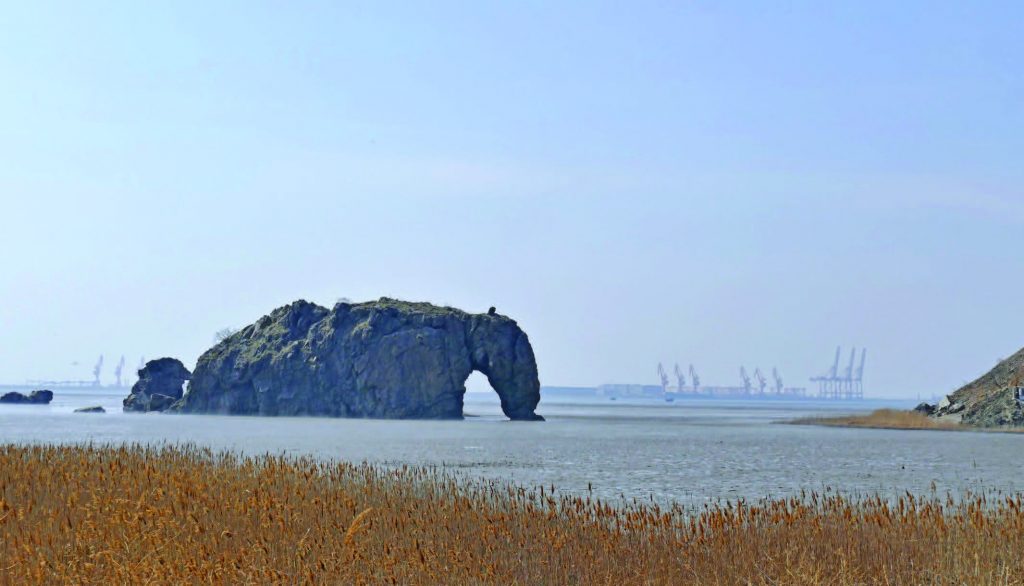
After three nights on Sindo we returned upriver to Sinuiju. The nighttime departure on a small boat was an adventure in itself. Clambering off the concrete jetty onto rocks and mud and then up a precarious plank to the bow of the boat, all by torchlight.
There followed over several hours a slow advance up the river, between banks of contrast. To the west – the brightly lit high rises of New Dandong, and then the spectacular riverfront of downtown Dandong: to the east the more modest and mainly dark skyline of Sinuiju. Waiting for the tide to allow docking it was just on midnight when we finally moored.
The second section of the survey was to be the coast immediately to the east of Sindo, extending south-east towards the last site visited by the team last year. But it did not quite work out that way. For one thing our departure from the hotel was delayed and this, together with a series of delays en route, meant we arrived on site close to full tide.
This is clearly a highly sensitive area with a marked increase in border guards and official scrutiny than we have experienced at sites further south. Which made us even more grateful for the work of Mr Ri in getting us this far. Our initial destination was a village and border post at the base of several small outcrops, beyond which were reed beds with a small river meandering through. Behind two young soldiers, we advanced out into the reeds. At first the ground was relatively firm and littered with fallen reeds. There then came a succession of detours around patches of water and soft mud, and narrow channels challenging to people of shorter stature. With our view constrained by 2m high reeds all around there was no way of knowing how far it was to the coast.
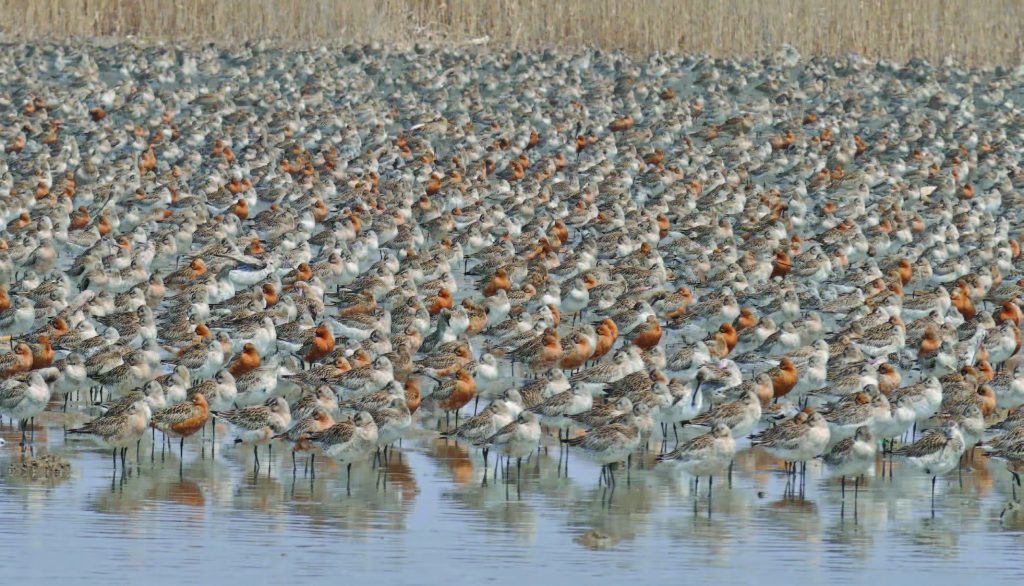
Eventually we came to the main channel where a secondary but equally impassable channel joined. The day was turning into a bust. We could see a few small airborne flocks, mainly curlew, in the distance but there was no way of advancing further.
Meanwhile Mr Ri and the soldiers were in discussion with some fishermen whose boat was moored near the channel junction. Before long we were clambering aboard for a look down the river. The boat was a tiny working vessel, its decks strewn with rope, a tool kit and other obstacles.
On board were the three fishermen, the two soldiers, the six of us, plus our six Korean colleagues together with the Korean film crew who were also filming the project.
Reeds lined both sides and extended as far as we could see in any direction, the only landmarks the outcrops and low hills that marked our departure point. Here and there on the banks were small flocks of curlew and Whimbrel all spooked into flight by our approach. Where side channels joined there were more birds together with a few dozen Dunlin. At the mouth of the river, about two kilometres from where we embarked, it became clear there were unlikely to be major shorebird roosts in the area, so the small flocks we saw represented a reasonable snapshot. It turned out to be a splendid day. We could not complete a full survey, but to experience the reed beds was good consolation. For David Melville, in particular, it was a memorable sight. ‘This is what the Jiangsu coast of China must have looked like back in the 1960s. And the whole Yellow Sea coast a hundred years ago.’ We were unable to travel further towards the area visited by the PMNT team last year, but at least we now knew something of the coast immediately east of Sindo. More importantly, we had confirmed the international importance of the Sindo area for shorebirds, especially Far Eastern Curlew and Bar-tailed Godwits. Indeed the DPRK probably holds the key to the Far Eastern Curlew’s survival.
